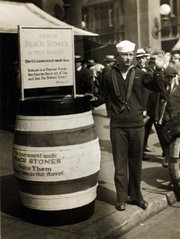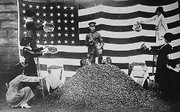Imagine yourself at a desk among other desks in a room of quietly concentrating co-workers. The tick-tack of computer keyboards underlines early morning calm.
Focused on your own computer, you are marching through digital pages of the Sept. 15, 1918, Arkansas Gazette, a pleasantly tedious landscape of vintage information in pale gray columns. Coffee mug to the left of you, computer mouse to your right, half awake, half awake, half awake, onward.
Suddenly your hand freezes, as though gripped by an outside spirit. It hovers above your little mouse.
See yourself lean forward. Squint at this headline:
Save Your Peach Seed and Help Win the War
You frown, of course. Then you enlarge the words on your computer screen. Read the first sentence of the 3-inch story:
Peach seeds will help win the war!
Right away you think of Pancho Villa. In 1914, the Gazette carried a report that the Mexican revolutionary general was not Mexican but instead an Oklahoman named George Goldsby who was remembered at Vinita, Okla., for marrying a black woman whose son had been hanged for murder.
That story was incorrect. Is this one?
The 1918 item states that something called Chemical Warfare Service, U.S.A., has called upon Americans to save their used peach pits -- to win the war.
Department stores in Boston and New York have placed big hogsheads painted red, white and blue at their main entrances. The public should deposit its peach pits there, as well as the stones of other fruits, including olives and date seeds. Nut shells, too.
Pfeifer Bros., of this city, receive seed and send them in to the proper authorities, for the people of Little Rock, and they have placed a receptacle for this purpose in front of their store. They ask that people dry the seed and drop them in this receptacle. Many seed have already been received.
Are you hissing at your nearest quietly concentrating co-worker, "You gotta hear this!" and then flailing your arms at her?
I did. Because it was true! In September 1918, on top of growing more cotton and home gardens and hogs, restricting their shopping, carrying their own groceries, eating less meat and less sugar and more eggs, turning off electric lights, staying off the telephone, turning their tattered dresses into fashionable frocks, waiting longer for the train, shooting no pigeons, studying no German, baking bread loaves of regimented dimension, adopting a French orphan, giving up baseball, giving random soldiers a lift in their autos, buying fewer Christmas gifts ... civilians also were supposed to save fruit pits, clean them and take them downtown to a barrel in front of a department store.
And people did.
Because charcoal was needed to make gas masks.
Very good charcoal could be made from peach, apricot, cherry and prune pits and olive pits, date seeds and nut shells. The little item quoted one J.S. Boyad of the Chemical Warfare Service, who said 200 peach pits or 7 pounds of nut shells would make carbon enough for one gas mask, "and one mask will save an American soldier's life."
In September 1918, the American Red Cross began a national campaign to collect tons and tons of pits for the War Department's Gas Defense Division, which was rushing to supply Allied troops with desperately needed gas masks.
World War I was the first chemists' war. Insidious clouds of poisons like tear gas, phosgene, chlorine, mustard gas and Prussic acid could infiltrate trenches that had thwarted whole armies. Germany fired the first gas salvo, but the Allies followed suit. Of the estimated 9 million lives taken by the Great War, "only" 90,000 deaths and 1.3 million casualties are attributed to gas attacks.
Thanks to gas masks.
The U.S. National Archives include a 6-minute silent film about the great peach pit donation drive, shot by the U.S. Signal Corps in September 1918. This is a wonderful little movie. It shows a Red Cross lady driving up to a mound of bags. Then the bags travel, first by truck and then by train, to smoking incinerators -- There is a gondola car piled with peach pits! Look at those big furnaces! -- Workmen roll barrels onto a platform, and then a long line of box cars conveys the barrels to the gas mask factory.
We tour a gas mask factory! (Sorry for all the exclamation points, I am getting excited about this all over again.) Hundreds of dexterous men and women are rapidly cutting and pasting, stamping out metal bits, pulling leavers, peering at glass discs, tugging straps -- quite an involved process involving lots of adhesive and obvious pride.
Here's a shortened link to the video: arkansasonline.com/917oldnews.
That link also will take you to a second video from 1918, this one about 9 minutes long, in which soldiers train with their gas masks at Camp McClellan in Alabama. At 2:58 in the film, hundreds of soldiers drill with their gas masks. But the film doesn't end there. It includes footage from Camp Pike in North Little Rock.
The Camp Pike part is nowhere near as diverting. We don't see hundreds of men flood down a hill, demonstrate bayonet attacks or stand at attention beside tepees of rifles and butterflied kit bags. But it is interesting to watch the commanding officer, Major Gen. S.D. Sturgis, his aides and foreign officers trot between a familiar set of stone gateposts on horseback. Without dismounting, he watches a regimental band and many soldiers parade, and there is a dog.
WAR IS JUST HELL
Speaking of general restrictions for the war effort, 100 years ago Sunday, the Gazette reported that the state Food Administration had banned the displaying of cakes and pies at county fairs.
"No perishable food must be used as an exhibit," states the edict. "Such exhibits would be in danger of spoiling, or would grow stale, in which event food of that nature would have to be thrown away and, therefore, be wasted. Concentrate your effort on an educational exhibit of a pictorial nature."
As an example of exhibitionary rectitude, the Food Administration had prepared its own exhibit, which would travel from fair to fair. Prepared by one Walter M. Ebel, it contained 10,000 pieces of educational material, including posters, window cards and photos and pictorial literature from the federal office. In addition, there were thousands of pamphlets dealing with food conservation and food conditions abroad.
Yum.
Infiltrate the Old News bunker by firing your email at these coordinates:
cstorey@arkansasonline.com
ActiveStyle on 09/17/2018

